.....When I was learning how to play
pool there were no books, no videos, no instructors and no leagues
to play in. The best way to learn was to watch. I was privileged
to see some of the greatest and some of the not so great. My
purpose for publishing my pointers insrtuctional column is not
only to inpart pool knowledge to my viewers but to share with the
public what these great players from the 1980s and 1990s looked
like. Through my trusty Canon, for a moment in time they are immortalized.
Some are still here and some are gone and I still remember the
joy of watching them play.

DON'T LAG BEHIND
Keep Our Traditions Rolling
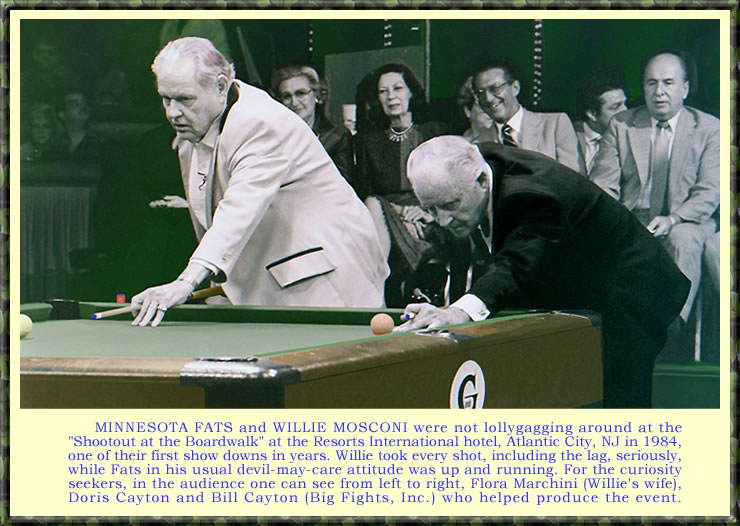
.....DESPITE THE FACT that the lag is an important part of the game, a lot of players take it lightly. The more serious player recognizes its true benefits and tries to capitalize on it. Beyond the obvious point that it is mechanically and psychologically important, it is a time honored tradition in the pocket billiard world of competition.
.....Let me begin by defining the “lag”. According to the World Pool-Billiard Association and, therefore the Billiard Congress of America who uses the same rules, the lag is the first shot of the match and determines the order of play. The player who wins the lag chooses who will shoot first. In my view, the lag is your first opportunity to take control of the game. It has the potential to be a huge psychological advantage.
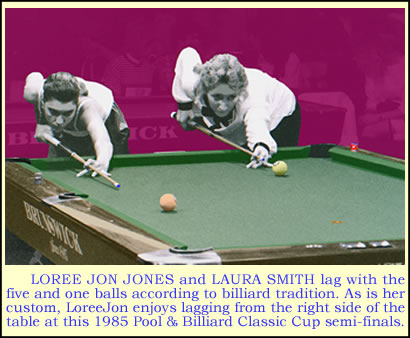
The Objective of the Lag
.....The referee places a ball on each side of the table behind the head string. The players shoot at about the same time. Each ball contacts the foot cushion, the goal being that the returning ball that gets closer to the head cushion wins the lag. It is alright to bounce off the head rail after contacting the foot cushion. This fact is sometimes disputed by beginners. A lag is bad and cannot win under the following circumstances:
.....You cannot cross the long string. Basically, that means stay on your side of the table. That makes sense since another element of the rule is you cannot interfere with your opponent’s ball. Your lag ball cannot go off the table, including going into a pocket, so watch your speed. Additionally, you cannot touch the side rails or land your lag inside the corner pocket and past the nose of the head cushion. How often is that going to happen! But I digress…
.....If you are in an organized event, the rules for subsequent breaks for short rack games are usually laid out for you. It could be winner breaks, loser breaks or alternate breaks. You are at the mercy of the organization. If you are playing a match in the pool room, be sure to define the ground rules for who's breaking ahead of time.
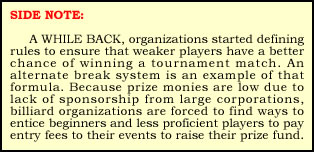
.....I once saw a player shoot his lag ball like a rocket before his opponent shot his lag ball. The ball went up and down the table three times before resting about a half inch from the head rail. Later, I asked the player why he did that. He basically said it was a case of shock and awe to his opponent. I guess that’s why they refined the rule to "you cannot touch the foot cushion more than once." If both lags do not adhere to the rules or the referee cannot determine which ball has stopped closer to the head cushion the players will re-lag.
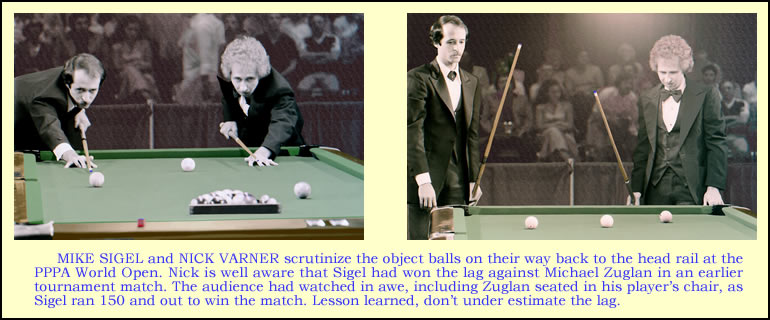
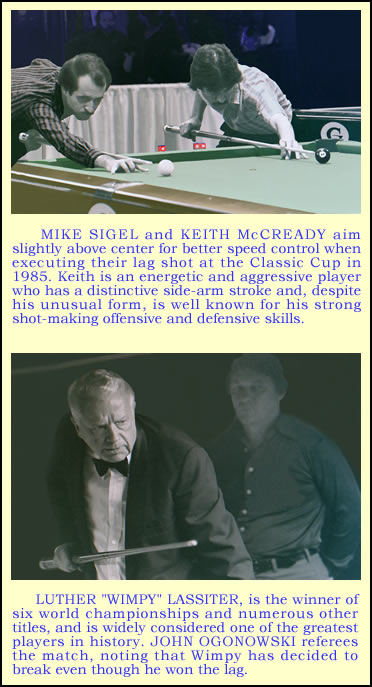
Who Should Break?
.....A player might mentally gear up for a game before it starts, but the actual moment when his or her concentration "turns on" is when facing the lag. As I stated before, it's your first opportunity to take control of the match and gain a psychological advantage. Most lag winners will take the break in eight-ball and nine-ball, but have their opponent break in straight pool. There's no rule saying that's the right move. On many occasions, I have seen top players give away the eight-ball break because they know their opponent has a weak break and/or can't run out. By giving the break to the opponent, they can come to the table with the balls open and, possibly, with some of the other player's group already pocketed. It makes for an easier run out. I consider eight ball to be straight pool with an obstacle course. It’s always a bonus when your opponent removes some of the impediments to your run out.
.....MIKE SIGEL and KEITH McCREADY both hit the lag ball slightly above center. I like this technique because a ball reverses its spin after hitting a rail. By hitting the ball above center on the lag, the object ball starts slowing down from the under spin it collects after bouncing off the foot rail. This gives the shooter a better chance at being near the head rail because the lag ball is slowing down on its way back.
.....If you are right handed it’s better to be on the right side of the table so your arm swings free and won’t be bumped by your opponent. Adversely, when a left handed player is lagging with a righty, it’s better for you both to be facing the inside of the table. Sometimes it’s a good idea to keep your eye on your opposition. Sigel and Mizerak, both left handers, always take the right hand side of the table when competing with a right hander.
.....I’ve seen players give up the nine-ball break but it's not as prevalent as in 8 ball. Knowing that your opponent can't run out and is not powerful enough to pocket the 9 ball on the break should be food for thought. I'm not recommending giving up the break, only that some thought go into it. Conversely, if your straight pool break is very strong, and your opponent is weak on long shots, why not try breaking yourself? Chances are they'll miss and leave you in the middle of an open rack. I saw LUTHER LASSITER win the lag at the World Open in 1980 and opt to take the break in his straight pool match. We can all learn from a Legend but be sure to first practice up on your straight pool break.
.....STEVE MIZERAK and JIMMY FUSCO intensely observe the close finish of their lag during the World Open. By the way, that's MIKE FUSCO, owner and operator of the Boulevard Billiard Club in Philadelphia, PA in the background to the right. Mike was one of the WPBA's supporters in its early days. (Take a peek at Mike and Jimmy on my Billie-isms page.) The players depict another great tradition adhered to by the PPPA in that both players needed to wear their jackets during the lag. Both of these players are class acts and gave a snappy look to this televised event.

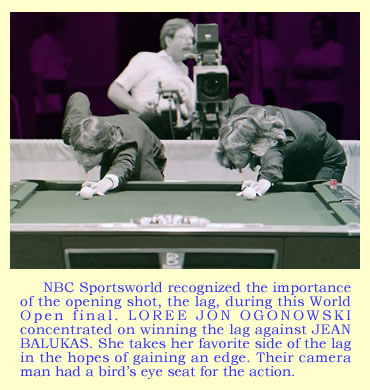
.....Winning the lag is a psychological advantage for you and a mental letdown for your opponent. It's a confidence builder to have just executed something better than your adversary. Another advantage to the lag is that it is a time to orient yourself to your surroundings. Maybe it’s the first time you’ve experienced being in an arena with an audience; or the first time you’re on TV; or being in a new room and challenging the unknown talent. Whatever the situation, chances are you need time to clear your head. A flip of a coin won’t do that for you, while winning the lag will give you time and a mental boost.
.....I’ve heard that players should lag with two cue balls because the weight of the cue balls is more consistent. I’m not sure about that. It may be true but doesn’t that mean that two object balls would also be consistently the same weight? More important, there may not be two cue balls available. I’m old school and know that it was always traditional to lag with the one and five balls. Let’s keep it that way; I love tradition. At the Texas River Open in 1984, every one lagged with the one and five balls as depicted by ALLEN HOPKINS and MIKE GULYASSY at the beginning of their match. Obviously, both players took the lag seriously.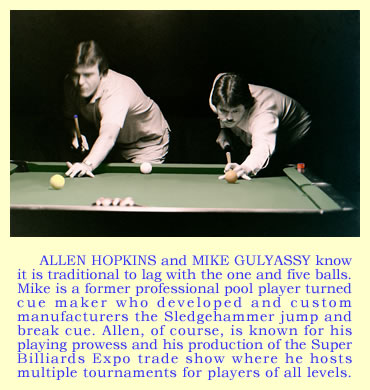
.....As with everything else, in order to be a skillful lagger you have to practice. I tell my students that practicing the lag is a wonderful exercise for a couple of reasons. Beginners and even some intermediate players have problems with hitting center ball and following through in a straight line. While practicing your lag, you are also practicing following through in a straight line. An exercise in lots of pool books is to place a ball on the head spot and shoot through the foot spot and try to make the ball bounce back over your initial spot to ensure you are following through in a straight line. Why not include an exercise in speed control to this popular practice drill? The slower you hit the ball, the more apt it is to go off line if not contacted dead on. Being successful at this slower speed is even more proof that you are stroking center ball accurately. At the same time, you are working on your lagging ability.
.....Pool has a mountain of poor public images to continuously climb. Some people do not even consider us to be a sport. In my view, it’s important to formulate traditions and trappings of an organized profession. The lag adds a touch of class to the game while giving you the advantage of the first successful attack in the contest. Instead of depending on luck, as in the flip of a coin, let skill and tradition come into play.

.

.....Pool Pointer Archives
.....1. Closed Half-Bridge
... .2. Look Before You Leap
.....3. Mechanically Inclined
.....4. Keep A Level Cue
.....5. Double or Nothing
.....6. Chalk It Up
.....7. V-Bridge It To Victory
.....8. The Right Combination
.....9. Referees; unsung heros
...10. Don't Lag Behind
.....Tune
in for more Pointer articles coming
your way each month.

|

